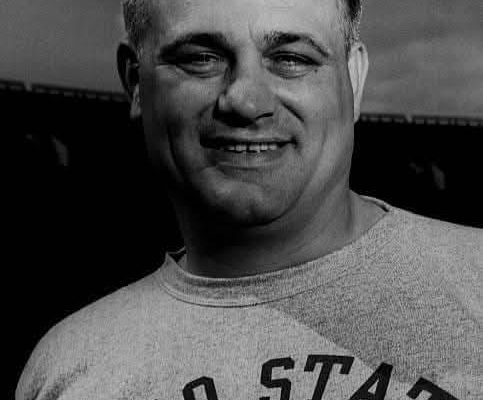Woody Hayes wasn’t just a football coach. He was a force of nature, a man whose unrelenting drive and unwavering devotion to The Ohio State University transformed not only the Buckeye football program but also the entire culture of college football. When he roamed the sidelines in the 1950s, clad in his iconic block “O” cap with his jaw clenched and eyes set ablaze by pure competitive fire, he was already becoming a living legend. There are few men in the history of sport—let alone college athletics—who have so profoundly imprinted their character and philosophy upon an institution. For Hayes, winning was never just about the scoreboard. It was about integrity, discipline, toughness, and the belief that every inch on the gridiron was earned through unselfish teamwork and sweat-stained perseverance.
Woody Hayes took over as head coach at Ohio State in 1951, and it didn’t take long for his presence to be felt. The early years were not easy, as he faced resistance from both the media and a fanbase that had grown skeptical after some uneven seasons under previous leadership. But Hayes wasn’t interested in popularity contests—he was building a machine. What many didn’t yet see was his iron-willed vision for what Buckeye football could become. His practices were grueling, his demands unrelenting. He valued military-style discipline, a commitment to physical dominance, and a strict adherence to fundamentals. Slowly but surely, his blueprint took shape, and the results spoke for themselves. Under Hayes, Ohio State would capture five national championships and 13 Big Ten titles, launching a program that would come to be defined by excellence and toughness.
The phrase “three yards and a cloud of dust” became synonymous with Hayes’ offensive philosophy. It was ground-and-pound, unflashy, and rooted in the belief that victory was forged in the trenches, not with trick plays or finesse. Some called it boring, but it was effective—and it reflected Hayes’ view of life itself. To Woody, success was never about shortcuts. It was about grinding through adversity, play after play, day after day. His offense wore teams down, play by punishing play, until they had nothing left to give. That’s what made his teams so hard to beat. That’s what made his players grow into men.
But Hayes wasn’t merely a football strategist. He was a teacher in the truest sense of the word. His former players often speak of how much they learned from him—not just about the game, but about life. He taught them to shake the hand of everyone they met with a firm grip. He taught them the value of punctuality, the necessity of humility, and the importance of serving others. Hayes was a voracious reader, deeply influenced by historical figures like Abraham Lincoln and Ulysses S. Grant. He frequently gave books to his players, lectured on military history, and expected his athletes to understand the world beyond football. In many ways, Woody Hayes was old school long before that phrase became cliché. He believed football could be a crucible for building character, and for over two decades, he used Ohio Stadium as his classroom.
The connection between Hayes and the Buckeye faithful was deeply emotional. Ohio State fans are famously passionate, but during the Hayes era, that passion reached fever pitch. He was not just a coach—he was an avatar of everything they held dear. Discipline. Grit. Pride. Hayes inspired not only respect, but devotion. His teams played with the same fire that burned in his eyes, and his sideline outbursts—whether directed at officials, players, or sometimes even himself—only reinforced his authenticity. He wasn’t polished or diplomatic. He was raw, real, and unequivocally committed to the cause. For generations of Buckeye fans, that commitment became something to rally around.
The rivalries during Hayes’ tenure were legendary. None more so than The Game—Ohio State vs. Michigan. Hayes took the rivalry to a new level of intensity, treating it not just as the biggest game of the season, but as a test of the program’s identity. His disdain for Michigan was well-documented and often theatrical. He once reportedly refused to buy gas in Michigan while on a recruiting trip, declaring he’d rather run out of fuel than spend a dime in enemy territory. When asked why he went for two in the closing minutes of a blowout win over Michigan, Hayes famously said, “Because I couldn’t go for three.” These anecdotes may sound like exaggeration, but they encapsulated the way Hayes approached competition—with everything he had.
Still, Woody Hayes’ story is incomplete without acknowledging the controversial and tragic end to his career. In 1978, during the Gator Bowl against Clemson, Hayes struck an opposing player who had intercepted a pass and sealed Ohio State’s defeat. The moment was captured on national television and immediately sparked outrage. It was an incident that could not be ignored, even by those who had revered Hayes for decades. The university swiftly dismissed him the next day, bringing a sudden and painful end to one of college football’s most storied coaching tenures. For many, it was a heartbreaking fall from grace—a reminder that even legends are flawed.
Yet over time, the bitterness of that ending has been softened by a broader appreciation for what Hayes contributed to the sport, the university, and the lives of countless young men. In the years following his dismissal, Hayes dedicated himself to public speaking, charity work, and mentoring. He became a quieter, more reflective figure, speaking often about humility and personal growth. When he passed away in 1987, the nation mourned not just a coach, but a cultural icon. Thousands gathered in Columbus to pay their respects, and his legacy was enshrined in the hearts of Buckeye fans forever.
The impact Woody Hayes left on The Ohio State University remains palpable. His name is etched into the Woody Hayes Athletic Center, but more than that, his spirit echoes through every fall Saturday in Columbus. The values he championed—toughness, loyalty, discipline, and an unrelenting pursuit of excellence—still serve as guiding principles for the program. Every time a Buckeye player takes the field, they carry forward a piece of Hayes’ legacy, whether they realize it or not.
There will never be another Woody Hayes. He came from a different time, operated by a different code, and built something that transcended wins and losses. To understand the story of Ohio State football is to understand the man in the block “O” cap, the coach who paced the sidelines with fire in his eyes and belief in his heart. Hayes was many things: a tactician, a teacher, a warrior, and at times, a flawed human being. But more than anything, he was the relentless architect of a dynasty that still stands tall today.
His methods may not all be replicated in the modern era, but his influence endures. From the banners hanging in the stadium to the countless lives he shaped, Woody Hayes’ mark on college football is permanent. For those who watched him coach, he wasn’t just a part of Ohio State—he was Ohio State. And for those who came after, his name is still spoken with reverence, his image still worn proudly on shirts and hats, and his legacy still passed down through stories, traditions, and the unwavering pride of Buckeye Nation.
In the end, Hayes didn’t just win games. He built a standard. He created a culture. And perhaps most importantly, he reminded everyone that greatness isn’t given—it’s forged. Three yards at a time.



